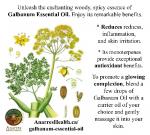Galbanum Essential Oil
Ferula galbaniflua steam distilled from the resin in Iran. also Ferula galbaniflua Boiss. et Buhse (F. rubicaulis Boiss.), fam. Apiaceae The gum resin is extracted by wounding the root or lower part of the stem.
Aroma: A top note with a medium aroma, galbanum essential oil possesses an intensely fresh, green leafy odour with a dry, bark-like back note. Alone, some find it to be an acute and unpleasant smell, hence its nickname “devils dung” in English.
Indigenous to northern Iran, galbanum is a small plant with the oil being distilled from the resin in the stems and roots. The plant was used for torches in ancient times, and it may have provided the torch with which Prometheus brought fire to humankind. It may also have been the 'green' incense used by the Egyptians, while the Hebrews used it in the Temple. In modern perfumery, it is considered to be the basis of the 'green' family of scents.
Common Uses: Galbanum resin has been widely used as incense and in perfumery since ancient times as evidenced by this passage from Hebrew scripture: Then the Lord said to Moses, 'Take fragrant spices - gum resin, onycha and galbanum - and pure frankincense, all in equal amounts, and make a fragrant blend of incense, the work of a perfumer.' - Exodus 30:34-35 (NIV) Galbanum is one of the four essential ingredients of the Holy Incense mentioned in Exodus 30:34 and Ecclesiastes 24:14–15. It was one of the ingredients of Ketoret (1), the Jewish Holy Incense that was burned in the Tabernacle in the 1 st and 2nd Jewish Temple at Jerusalem. The scent is calming and prepares the body, mind and spirit for prayer and meditation.
Nomads of southwestern Iran have traditionally used the plant as an antidiarrheal. Ancient Iranian medical literature refers to it as an anticonvulsant, antispasmodic, expectorant, and wound treatment. In Iranian traditional medicine, an oleo-gum- resin obtain from F. gummosa is popular for treating various disorders that include stomach ache, cholera, diarrhea, epilepsy, inflammation, and pain. In a review of the species conducted by Nabavi et al. (2012) in Iran, the anti-oxidant action of the gum was studied and validated.
Therapeutically, galbanum essential oil is probably known for anti-inflammatory, anti-microbial and nervine properties. Inflammatory skin disorders, acne, pimples, cuts, wounds, scars, bronchitis, coughs, respiratory issues, inflammatory muscular aches and pains, rheumatoid arthritis, indigestion, nerve-related conditions. [Valerie Ann Worwood, The Complete Book of Essential Oils and Aromatherapy, 25th Anniversary Edition (Novato, CA: New World Library, 2016, 590.]
Main Constituents:
Pinenes > 50 % (b-Pinene: 38.6%)
delta-3-carene 20 %
d-limonene 5.0 %
alpha-Cedrene 0.1 - 1.0 %
7-methyl-3-methyleneocta-1,6-diene 1.0 %
B-Pinene
Gamma-3-Carene
a-Pinene
Sabinene
B-Myrecene
(+)-Limonene
See Essential Oil Safety for more complete list of constituents.
[B.M. Lawrence, Essential Oils 1988-1991 (Wheaton: Allured Publishing, 1993), 82-83. A. Ghannadi, S. Amree, Volatile Oil Constituents of Ferula gummosa Boiss from Kashan, Iran. (Journal of Essential Oil Research 14, 2002), 420-421. Sources cited in Robert Tisserand and Rodney Young, Essential Oil Safety (Second Edition. United Kingdom: Churchill Livingstone Elsevier, 2014), 290.]
Description / Colour / Consistency: A viscous, colourless to pale olive yellow liquid.
Cautions: Dilute before use; for external use only. May cause skin irritation in some individuals; a skin test is recommended prior to use. Contact with eyes should be avoided.
Essential Oil Safety Information
Tisserand and Young do not indicate any special precautions when using Galbanum Oil. However, they precaution to avoid use of the oil if it has oxidized. Reading Tisserand and Young's full profile is recommended. [Robert Tisserand and Rodney Young, Essential Oil Safety (Second Edition. United Kingdom: Churchill Livingstone Elsevier, 2014), 290.]
Illustration thanks to By Franz Eugen Köhler, Köhler's Medizinal-Pflanzen - List of Koehler Images, Public Domain, https://commons.wikimedia.org/w/index.php?curid=255560
Photo thanks to Uznature.uz, CC BY 4.0, via Wikimedia Commons



